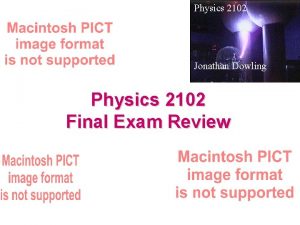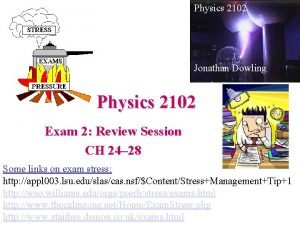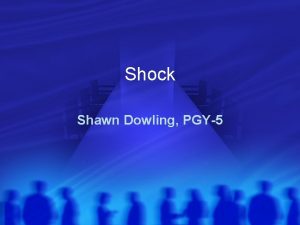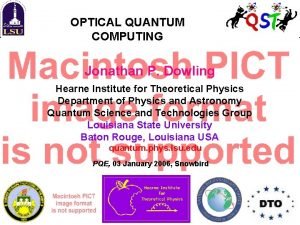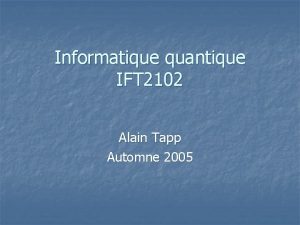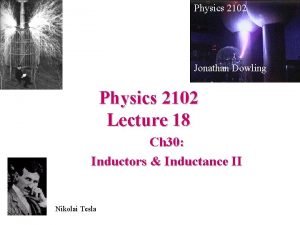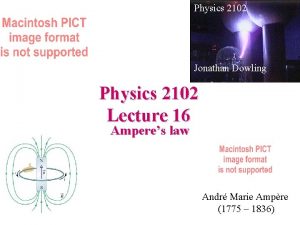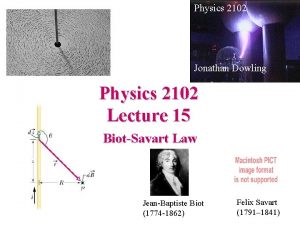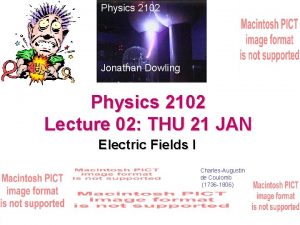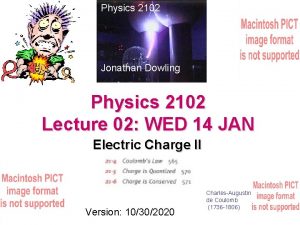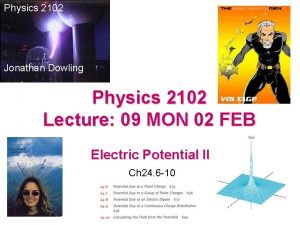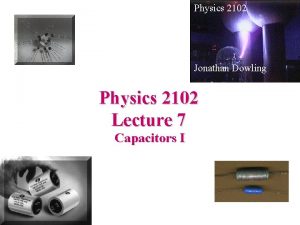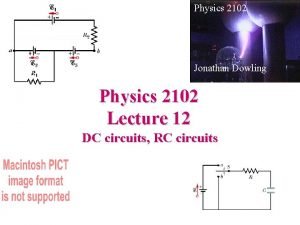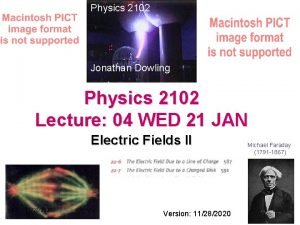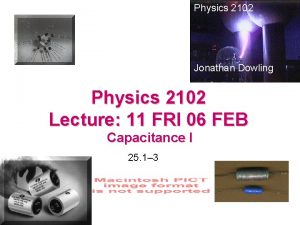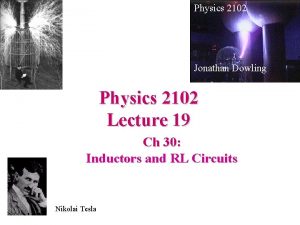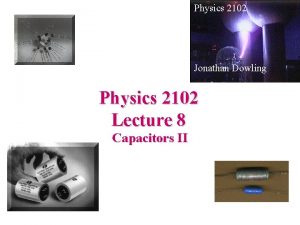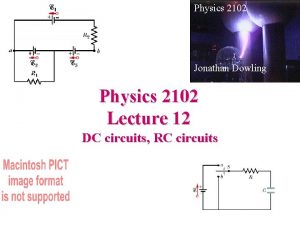Physics 2102 Jonathan Dowling Physics 2102 Lecture 03






















- Slides: 22

Physics 2102 Jonathan Dowling Physics 2102 Lecture: 03 TUE 26 JAN Electric Fields II Michael Faraday (1791 -1867)

What Are We Going to Learn? A Road Map • Electric charge - Electric force on other electric charges - Electric field, and electric potential • Moving electric charges : current • Electronic circuit components: batteries, resistors, capacitors • Electric currents - Magnetic field - Magnetic force on moving charges • Time-varying magnetic field �Electric Field • More circuit components: inductors. • Electromagnetic waves - light waves • Geometrical Optics (light rays). • Physical optics (light waves)

Coulomb’s Law For Charges in a Vacuum k= Often, we write k as:

E-Field is E-Force Divided by ECharge Definition of Electric Field: E-Force on Charge +q 1 –q 2 P 1 P 2 E-Field at Point –q 2 P 1 Units: F = [N] = [Newton] ; P 2 E = [N/C] = [Newton/Coulomb]

Force on a Charge in Electric Field Definition of Electric Field: Force on Charge Due to Electric Field:

E Force on a Charge in Electric Field +++++ Positive Charge Force in Same Direction as EField (Follows) ––––– +++++ E ––––– Negative Charge Force in Opposite Direction as EField (Opposes)

Electric Dipole in a Uniform Field • Net force on dipole = 0; center of mass stays where it is. • Net TORQUE : INTO page. Dipole rotates to line up in direction of E. • | | = 2(q. E)(d/2)(sin ) = (qd)(E)sin = |p| E sin = |p x E| • The dipole tends to “align” itself with the field lines. • What happens if the field is NOT UNIFORM? ? Distance Between Charges = d

Electric Charges and Fields First: Given Electric Charges, We Calculate the Electric Field Using E=kqr/r 3. Charge Produces EField Example: the Electric Field Produced By a Single Charge, or by a Dipole: Second: Given an Electric Field, We Calculate the Forces on Other Charges Using F=q. E Examples: Forces on a Single Charge When Immersed in the Field of a Dipole, Torque on a Dipole When Immersed in an Uniform Electric Field. E-Field Then Produces Force on Another Charge

Continuous Charge Distribution • Thus Far, We Have Only Dealt With Discrete, Point Charges. q • Imagine Instead That a Charge q Is Smeared Out Over A: q – LINE q – AREA – VOLUME • How to Compute the Electric Field E? Calculus!!! q

Charge Density • Useful idea: charge density • Line of charge: charge per unit length = • Sheet of charge: = q/L charge = q/A per unit area = • Volume of charge: per unit volume = charge = q/V

Computing Electric Field of Continuous Charge Distribution • Approach: Divide the Continuous Charge Distribution Into Infinitesimally Small Differential Elements dq • Treat Each Element As a POINT Charge & Compute Its Electric Field • Sum (Integrate) Over All Elements • Always Look for Symmetry to Simplify Calculation! dq = d. L dq = d. S dq = d. V

Differential Form of Coulomb’s Law E-Field at Point q 2 P 1 Differential d. E-Field at Point P 1 P 2 dq 2

Field on Bisector of Charged Rod • Uniform line of charge +q spread over length L • What is the direction of the electric field at a point P on the perpendicular bisector? (a) Field is 0. (b) Along +y (c) Along +x • Choose symmetrically located elements of length dq = dx • x components of E cancel P y x dx a o L dx q

Line of Charge: Quantitative • Uniform line of charge, length L, total charge q • Compute explicitly the magnitude of E at point P on perpendicular bisector • Showed earlier that the net field at P is in the y direction — let’s now compute this! P y a x o L q

Line Of Charge: Field on bisector Distance hypotenuse: d. E P Charge per unit length: [C/m] a r dx x o L q Adjacent Over Hypotenuse

Line Of Charge: Field on bisector Integrate: Trig Substitution! Point Charge Limit: L << a Line Charge Limit: L >> a Units Check! Coulomb’s Law!

Binomial Approximation from Taylor Series: x<<1

Example — Arc of Charge: Quantitative y • Figure shows a uniformly charged rod of charge -Q bent into a circular arc of radius R, centered at (0, 0). • Compute the direction & magnitude of E at the origin. –Q E 450 x y d. Q = Rdq d x = 2 Q/(p. R)

Example : Field on Axis of Charged Disk • A uniformly charged circular disk (with positive charge) • What is the direction of E at point P on the axis? (a) Field is 0 (b) Along +z (c) Somewhere in the x-y plane P z y x

Example : Arc of Charge • Figure shows a uniformly charged rod of charge –Q bent into a circular arc of radius R, centered at (0, 0). • What is the direction of the electric field at the origin? (a) Field is 0. (b) Along +y (c) Along -y y x • Choose symmetric elements • x components cancel

Summary • The electric field produced by a system of charges at any point in space is the force per unit charge they produce at that point. • We can draw field lines to visualize the electric field produced by electric charges. • Electric field of a point charge: E=kq/r 2 • Electric field of a dipole: E~kp/r 3 • An electric dipole in an electric field rotates to align itself with the field. • Use CALCULUS to find E-field from a continuous charge distribution.

 E=q/ae0
E=q/ae0 Jonathan dowling
Jonathan dowling International human resource management dowling 6th edition
International human resource management dowling 6th edition Shock mnemonic
Shock mnemonic Dowling optical
Dowling optical Dowling roundabout
Dowling roundabout 01:640:244 lecture notes - lecture 15: plat, idah, farad
01:640:244 lecture notes - lecture 15: plat, idah, farad Texas secretary of state apostille
Texas secretary of state apostille Ift-2102
Ift-2102 Nutrition 2102
Nutrition 2102 Nutrition 2102
Nutrition 2102 Nutrition 2102
Nutrition 2102 What is a harmonic wave in physics
What is a harmonic wave in physics Physics 101 lecture notes pdf
Physics 101 lecture notes pdf Physics 101 lecture 1
Physics 101 lecture 1 Notes on waves physics pdf
Notes on waves physics pdf Classical mechanics
Classical mechanics Atmospheric physics lecture notes
Atmospheric physics lecture notes Why does it happen
Why does it happen University physics with modern physics fifteenth edition
University physics with modern physics fifteenth edition Physics ia topic
Physics ia topic Msrp protocol
Msrp protocol Jonathan nulty pittsburgh
Jonathan nulty pittsburgh
